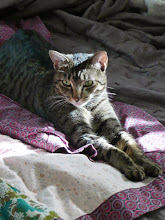IF the cat has been exiled from ecclesiastical architecture, she has triumphed in Christian art. The early Italian masters admitted her over and over again into their sacred pictures, painting her lovingly, and with a delicate appreciation, not only of her grace, but of her domestic character, as though they sought to represent through her the human, earthly, simple life which they blended so sweetly with the mysterious and divine. In many pictures of the Annunciation we find a cat drowsing upon the Blessed Virgin's work-basket, or curled up on a corner of her azure robe. We see her repeatedly in paintings of the Last Supper, the Marriage Feast at Cana, and the birth of the Blessed Virgin; which final subject — so dear to the Italian heart — was seldom deemed complete without the introduction of a cat into the spacious bed-chamber of Saint Ann.
This is all the more pleasing because of Pussy's conspicuous absence from Pagan art. The dog leaps by the side of Artemis, or bays at the moon while Endymion slumbers. The kid drinks from the shepherd's bowl, the young bull is led garlanded to the sacrifice, the stag falls, pierced by the hunter's dart. But of the little fireside Sphinx we have no sign nor token. She and she alone finds no place among the marble animals of the Vatican. Those wise and watchful hounds, those lions and wolves and spotted leopards make no room for her. We see the hare couching upon her form, and the lobster lying on its rocky bed; but for the most beautiful of domestic animals we search, and search in vain.
Only in the Capitoline Museum may be found a spirited bas-relief, of a late period, which represents a woman trying to teach her cat to dance to the music of a lyre. The cat, a sullen beast with no love of music or dancing in its soul, has paused in the unwelcome task to snap viciously at a young duck, which, with obvious lack of caution, is thrusting forward its inquisitive head.
-- from Agnes Repplier, The Fireside Sphinx (Houghton, Mifflin and Co., 1901), pps. 104-5 (the beginning of Chapter VI, "The Cat in Art," which includes the illustration above. Text and image not in copyright.)


1 comment:
And on to the internet age, where Cats rule the web!
Post a Comment